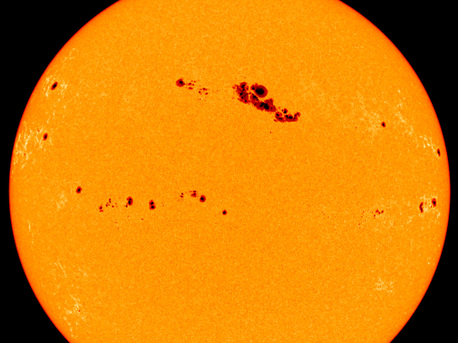Learn about Sun Spots
Why does the Sun have black spots?
The concept that a heavenly body such as the Sun should not be flawless: this sacrilegious idea bordered on blasphemy and got the natural scientist Galileo Galilei (1564–1642) into trouble with the Catholic church. However, he was not the first to concern himself with the dark areas on the Sun's surface.
 © NASA |
The spacecraft SOHO (Solar and Heliospheric Observatory) took this picture of the Sun's surface, showing an unusually large number of sunspots, in March 2001. Sunspots are caused by differences in temperature on the Sun's surface: cooler points appear as black spots.
The black spots had already been described in antiquity. They had been systematically observed since the invention of the telescope at the beginning of the 17th century. The sunspots are caused by differences in temperature on the Sun's surface. Hot matter is continuously swirling out to the Sun's surface from its interior. This so-called convection can be inhibited by local increases in the Sun's magnetic field – this creates spots on the Sun's surface that are somewhat cooler and which then become visible as sunspots.
'Somewhat cooler' refers to the average surface temperature of around 6000 degrees Celsius. The core area of the spots (the umbra) is 'only' 4000 degrees Celsius, the peripheral area (the penumbra) is a good 5000 degrees Celsius. At these temperatures, the spots are also white hot, however the difference in temperature causes the light to be filtered and the spots appear black.
'Somewhat cooler' refers to the average surface temperature of around 6000 degrees Celsius. The core area of the spots (the umbra) is 'only' 4000 degrees Celsius, the peripheral area (the penumbra) is a good 5000 degrees Celsius. At these temperatures, the spots are also white hot, however the difference in temperature causes the light to be filtered and the spots appear black.
The number of sunspots fluctuates significantly
The incidence of sunspots is related to the level of the Sun's activity and changes in an 11-year cycle. During a minimum of the sunspot cycle there are often periods of several months during which no spots can be seen. At a sunspot maximum there can be hundreds of them. The spatial distribution of the spots across the Sun's surface and their magnetic orientation change during an 11-year cycle. Consequently, a complete sunspot cycle actually takes 22 years.
At present, we are experiencing a minimum of solar activity that is lasting a surprisingly long time. The next maximum is expected in 2012. A glance at the website spaceweather.com shows how many sunspots exist at present. It can be exciting to make your own observations through a telescope. A suitable filter is absolutely vital, as viewing the Sun without protection can damage the eyes and lead to blindness.
German Aerospace Centert
German Aerospace Centert
Learn about Sun Spots
Why does the Sun have black spots?
The concept that a heavenly body such as the Sun should not be flawless: this sacrilegious idea bordered on blasphemy and got the natural scientist Galileo Galilei (1564–1642) into trouble with the Catholic church. However, he was not the first to concern himself with the dark areas on the Sun's surface.
 © NASA |
The spacecraft SOHO (Solar and Heliospheric Observatory) took this picture of the Sun's surface, showing an unusually large number of sunspots, in March 2001. Sunspots are caused by differences in temperature on the Sun's surface: cooler points appear as black spots.
The black spots had already been described in antiquity. They had been systematically observed since the invention of the telescope at the beginning of the 17th century. The sunspots are caused by differences in temperature on the Sun's surface. Hot matter is continuously swirling out to the Sun's surface from its interior. This so-called convection can be inhibited by local increases in the Sun's magnetic field – this creates spots on the Sun's surface that are somewhat cooler and which then become visible as sunspots.
'Somewhat cooler' refers to the average surface temperature of around 6000 degrees Celsius. The core area of the spots (the umbra) is 'only' 4000 degrees Celsius, the peripheral area (the penumbra) is a good 5000 degrees Celsius. At these temperatures, the spots are also white hot, however the difference in temperature causes the light to be filtered and the spots appear black.
'Somewhat cooler' refers to the average surface temperature of around 6000 degrees Celsius. The core area of the spots (the umbra) is 'only' 4000 degrees Celsius, the peripheral area (the penumbra) is a good 5000 degrees Celsius. At these temperatures, the spots are also white hot, however the difference in temperature causes the light to be filtered and the spots appear black.
The number of sunspots fluctuates significantly
The incidence of sunspots is related to the level of the Sun's activity and changes in an 11-year cycle. During a minimum of the sunspot cycle there are often periods of several months during which no spots can be seen. At a sunspot maximum there can be hundreds of them. The spatial distribution of the spots across the Sun's surface and their magnetic orientation change during an 11-year cycle. Consequently, a complete sunspot cycle actually takes 22 years.
At present, we are experiencing a minimum of solar activity that is lasting a surprisingly long time. The next maximum is expected in 2012. A glance at the website spaceweather.com shows how many sunspots exist at present. It can be exciting to make your own observations through a telescope. A suitable filter is absolutely vital, as viewing the Sun without protection can damage the eyes and lead to blindness.
German Aerospace Centert
German Aerospace Centert








